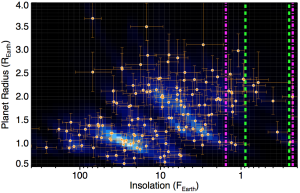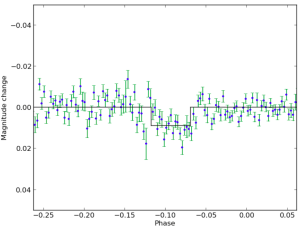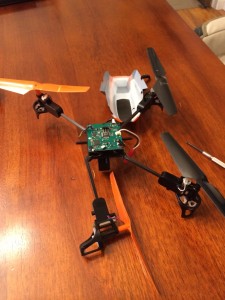Took Blade 180QX to Boise High School downtown at sunset
Archives
All posts for the month June, 2015
I gave a presentation at University of Maryland’s Astronomy Department today, Jun 26 on my dust devil work. Here it is. Abstract below.
Summoning Devils in the Desert
Brian Jackson (bjackson@boisestate.edu)
Dept. of Physics, Boise State University, Boise ID
Dust devils are small-scale (few to many tens of meters) low-pressure vortices rendered visible by dust lofted in moderate to high (> 10 m/s) winds. They persist for minutes to hours and can travel kilometers, usually carried by the ambient wind. On Earth, they occur primarily in arid locations and can reduce air quality and endanger small aircraft. On Mars, they occur ubiquitously and likely dominate the supply of atmospheric dust, influence climate, and even lengthen the operating lifetimes of solar-powered landers. Studied for decades, the underlying formation, dynamics, and statistics of dust devils remain poorly understood, but the same technology revolution that brought us stealth drones and iPhones is helping to change that. In this presentation, I’ll discuss on-going field surveys involving miniature, autonomous instrumentation deployed at sites known for dust devil activity. Using a combination of pressure loggers and photovoltaic cells, these surveys are helping to reveal the underlying natures and structure of dust devils in a totally novel way. We’ve found, for example, that not all devils are dusty, but the dustiest devils are also probably the biggest. The most vigorous dust devils occur most frequently during the middle of the day in the summer, when convection driven by insolation is the most active, but low-pressure vortices apparently occur year-round, throughout the day and night. As in astronomical surveys, statistical inference using these results requires assessing important biases, including selection and detection biases, largely unconsidered in previous surveys. Accurately assessing the role of dust devils requires a complete knowledge of their population statistics since the influence of the largest and most rare devils may drastically outweigh that of smaller, more common devils.
At research group meeting on Thursday, we discussed a recent paper by Zhang and colleagues that investigated the performance of Canon’s EOS 60D and whether it was suitable to use for precision photometry to look for exoplanet transits.
Although the authors found the camera exhibited a few peculiarities (that are apparently not described in any of Canon’s documentation), they showed that it could be used to observe exoplanet transits — a really great result.
It means that astronomers, amateur or professional, who want to do transit observations don’t need to spend $10,000 to buy a high-end CCD camera. Instead, they can spend just a few hundred to produce reasonable quality transit light curves.
One especially tantalizing result from the paper: Zhang and colleagues mention having seen exoplanet transit-like signals for four of the target stars they studied, only one of which is known to host a planet — KELT-3 b. That means they may not only have recovered known transiting with the Canon EOS 60D; they may also have found three new ones. Presumably, they’re in the process of trying to confirm whether the other three are new planets.
UPDATE: The authors kindly updated me to say that follow-up observations indicated these three candidates are all false positives. But they would have discovered KELT-3 b with their survey, if it hadn’t already been discovered. So a pretty amazing achievement.
Attendees included Jennifer Briggs, Andrew Farrar, Nathan Grigsby, Emily Jensen, and Tyler Wade.
In prep for an upcoming project (and because it’s ridiculously fun), I bought a Blade 180QX multicopter. It’s very easy to fly for someone like me who has no experience, and it comes with a nice camera (although not with the required micro SD card).
I shot this video this evening from Boise’s North End, taking off from North Junior High. I got a nice shot of the foothills, downtown, and the capital building. Be warned: the propellers are really loud.
In anticipation of the upcoming New Horizons fly-by of the Pluto system, a really exciting result from Mark Showalter of SETI and Doug Hamilton of UMD — complex gravitational interactions among the moons of Pluto, Charon, Styx, Nix, Kerberos, and Hydra, have driven Nix mad and make it rotate chaotically. A simulation of its rotational evolution is shown in the youtube video above.
Showalter and Hamilton analyzed Hubble images of the Pluto system to understand how the moons’ orbits evolve as the result of the gravitational tugs between the moons. The three moons Styx, Nix, and Hydra are very near to and probably in a three-body resonance reminiscent of the Galilean satellites. Computer models of that interaction allowed them to constrain the masses of the moons, somewhere in the range of Mars’ moon Deimos‘ mass.
We would expect that the complex gravitational environment as applied to such elongated moons would likely lead to complex rotation, and indeed, Showalter and Hamilton find that the phase curve for Nix, observed from 2010 to 2012, varies erratically, consistent with a chaotic rotation. Their analysis also shows that Hydra rotates chaotically; probably some of the other moons (except for Charon) as well.
One bit of good news for the New Horizons flyby emerges from all this: the systems’ chaotic dynamics probably keep it clear of rings or additional small moons that would pose hazards for New Horizons. It seems nature has decided the system is complicated enough already.
Attendees at today’s journal club included Jennifer Briggs, Emily Jensen, and Tyler Wade.

The radii of planets found in the Kepler dataset by Dressing & Charbonneau (2015) as a function of the amount of star light (insolation) they receive. The pink and green lines show ranges of insolation we think might allow the planets to be habitable.
In journal club today, we discussed a recent study by Dressing & Charbonneau (2015) that used the Kepler dataset to search for possibly habitable planets around small (M-dwarf) stars.
Dressing and Charbonneau applied a sophisticated and comprehensive search scheme to look for habitable planets and estimate how effective their search was in finding such planets. Based on their analysis, they estimated that about 1 in 4 M-dwarf stars have planets about the size of Earth in their habitable zones and that the nearest such planet is about 8.5 light years away.
This is far enough that we’d probably still need a generation ship to reach it but a lot closer than one case, 20 light years to the nearest habitable planet, considered by Hein et al. (2012) in their analysis of interstellar colonization. This reduction in travel time could reduce the minimum population required to make the trip from maybe 7,000 to 4,000 people.
Of course, the habitable planet sought in such a trip would orbit a much cooler, redder star than the Sun, so the colonists should be prepared to plant very different crops than we have on Earth.
Attendees of today’s journal club included Simon Pintar, Nathan Grigsby, Jacob Sabin, Tyler Wade, Liz Kandziolka, Jennifer Briggs, and Emily Jensen.

